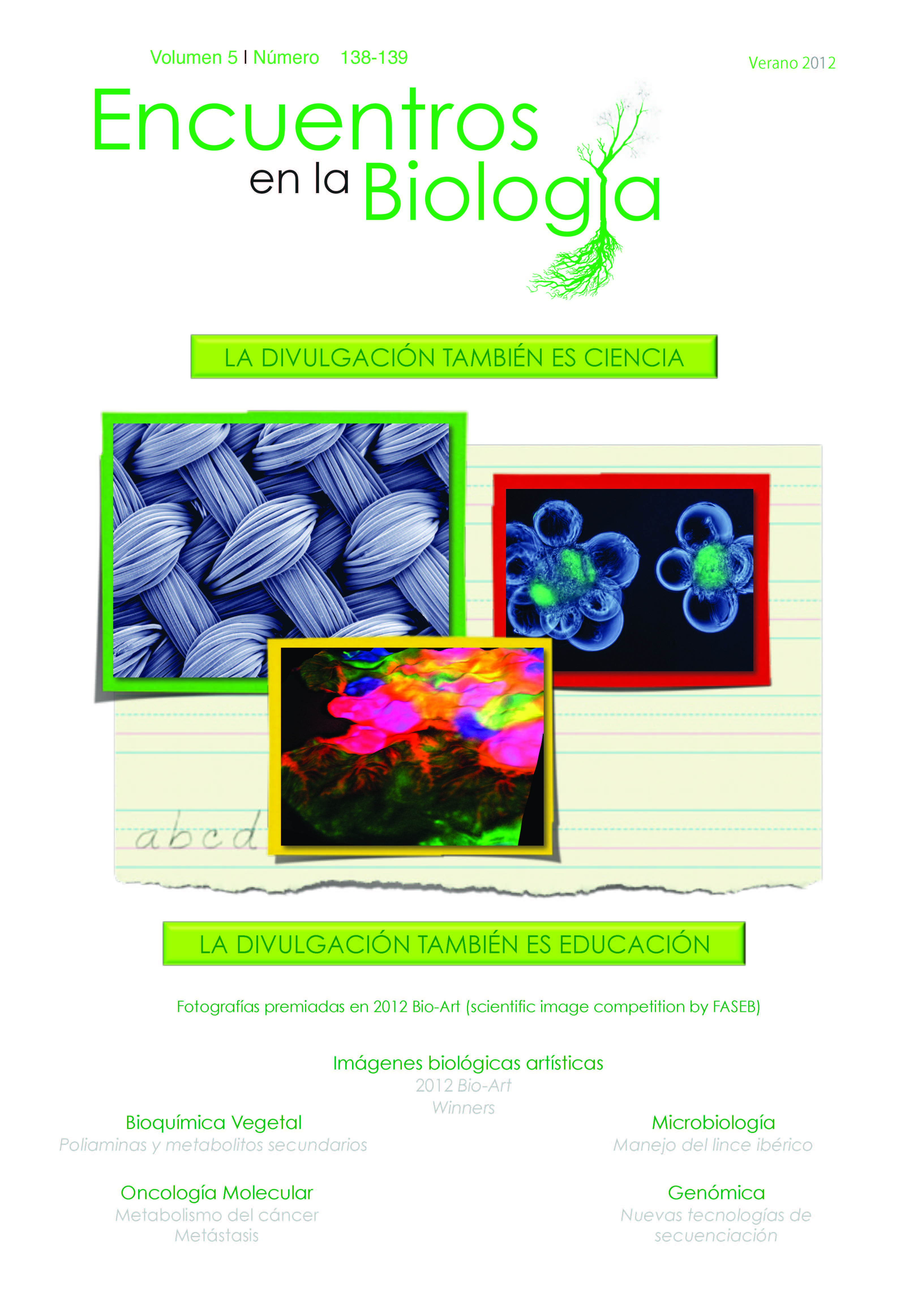Metabolismo y cáncer
Palabras clave:
cáncer, metabolismo, transformación tumorigénicaResumen
La perspectiva de investigación en el cáncer ha estado basada durante mucho tiempo en la detección de aquellos genes implicados en la transformación tumorigénica. Es cierto que el peso de éstos en la aparición de células cancerosas esta más que contrastado (Lane, 1992), pero en los últimos tiempos se han hecho numerosos avances en la comprensión como de como el metabolismo de las c´´elulas cancerosas les permite mantener un fenotipo maligno, hasta el punto de llegar a ser designado recientemente como una de las nuevas señas de identidad del cáncer ( Hanahan y Weinberg, 2021)
Descargas
Métricas
Citas
Gottlieb E, Tomlinson IP (2005). Mitochondrial tumor supressors: a genetic and biochemical update. Nature reviews cancer 5: 857-866.
Haigis MC, Sinclair DA (2010). Mammalian sirtuins: biological insights and disease relevance. Annual Review Pathology 5: 253-295.
Hanahan D, Weinberg RA (2011). Hallmarks of cancer: the next generation. Cell 144: 646-674
Hatzivassiliou G, Zhao F, Bauer DE, Andreadis C, Shaw AN, Dhanak D, Hingorani SR, Tuveson DA, Thompson CB (2005). ATP citrate lyase inhibition can suppress tumor cell growth. Cancer cell 8: 311-321.
Hsu P, Sabatini D (2008). Cancer cell metabolism: Warbug and Beyond. Cell 134: 703-708
Koukourakis MI, Giatromanolaki A, Harris AL, Sivridis E (2006). Comparison of metabolic pathways between cancer cells and stromal cells in colorectal carcinomas: a metabolic survival role for tumor associated stroma. Cancer research 66: 632-637.
Kroemer G, Pouyssegur J (2008). Tumor cell metabolism: Cancer´s achilles heel. Cancer cell 13: 472-482
Lane D (1992). p53, the guardian of genome. Nature 358: 6-15.
Mazurek S, Boschek CB, Hugo F, Eigenbrodt E (2005). Pyruvate Kinase type M2 and its role in tumor growth and spreading. Seminars cancer biology 15: 300-308.
Menendez JA, Lupu R (2007). Fatty acid synthase and the lipogenic phenotype in cancer pathogenesis. Nature Reviews Cancer 7: 763-777.
Pedersen PL (2007). Warbug, me and Hexokinase 2: Multiple discoveries of key molecular events underliying one of cancer´s most common phenotypes the “Warbug effect”. Journal Bioenergetics Biomembranes 39: 211-222.
Tisdale MJ (2002). Cachexia in cancer patients. Nature Reviews Cancer 2 862-871.
Trachooman D, Alexandre J, Huang P (2009). Targeting cancer cells by ROS-mediated mechanisms: a radical therapeutic approach? Nature Reviews Drug Discovery 8: 579-591.
Wang HQ, Altomare DA, Skele KL, Poulikakos PI, Kuhajda FP, Di Cristofano A, Testa JR (2005). Positive feedback regulation between AKT
activation and fatty acid synthase expression in ovarían carcinoma cells. Oncogene 24: 3574-3582.
Warbug O, Posener K, Negelein E (1924). Über den Stoffweschsel der tumoren. Biochemie Zentrum 152, 319-344.
Young CD, Anderson SM (2008). Sugar and fat - that’s where it’s at: metabolic changes in tumors. Breast Cancer Research 10: 202-211.
Descargas
Publicado
Cómo citar
Número
Sección
Licencia
Esta obra está bajo licencia internacional Creative Commons Reconocimiento-NoComercial-CompartirIgual 4.0.
Esta revista provee acceso libre inmediato a su contenido bajo el principio de hacer disponible gratuitamente la investigación al público. Todos los contenidos publicados en Encuentros en la Bilogía están sujetos a la licencia Creative Commons Reconocimento-NoComercia-Compartirigual 4.0 cuyo texto completo puede consultar en <http://creativecommons.org/licenses/by-nc-sa/4.0>
Se pueden copiar, usar, difundir, transmitir y exponer públicamente, siempre que:
Se cite la autoría y la fuente original de su publicación (revista, editorial y URL de la obra).
No se usen para fines comerciales.
Se mencione la existencia y especificaciones de esta licencia de uso
Los derechos de autor son de dos clases: morales y patrimoniales. Los derechos morales son prerrogativas perpetuas, irrenunciables, intransferibles, inalienables, inembargables e imprescriptibles. De acuerdo con la legislación de derechos de autor, Encuentros en la Biología reconoce y respeta el derecho moral de los autores/as, así como la titularidad del derecho patrimonial, el cual será cedido a la Universidad de Málaga para su difusión en acceso abierto. Los derechos patrimoniales, se refieren a los beneficios que se obtienen por el uso o divulgación de las obras. Encuentros en la Biología se publica en open access y queda autorizada en exclusiva para realizar o autorizar por cualquier medio el uso, distribución, divulgación, reproducción, adaptación, traducción o transformación de la obra.
Es responsabilidad de los autores/as obtener los permisos necesarios de las imágenes que están sujetas a derechos de autor.
Los autores/as cuyas contribuciones sean aceptadas para su publicación en esta revista conservarán el derecho no exclusivo de utilizar sus contribuciones con fines académicos, de investigación y educativos, incluyendo el auto-archivo o depósito en repositorios de acceso abierto de cualquier tipo.
La edición electrónica de esta revista esta editada por la Editorial de la Universidad de Málaga (UmaEditorial), siendo necesario citar la procedencia en cualquier reproducción parcial o total.

